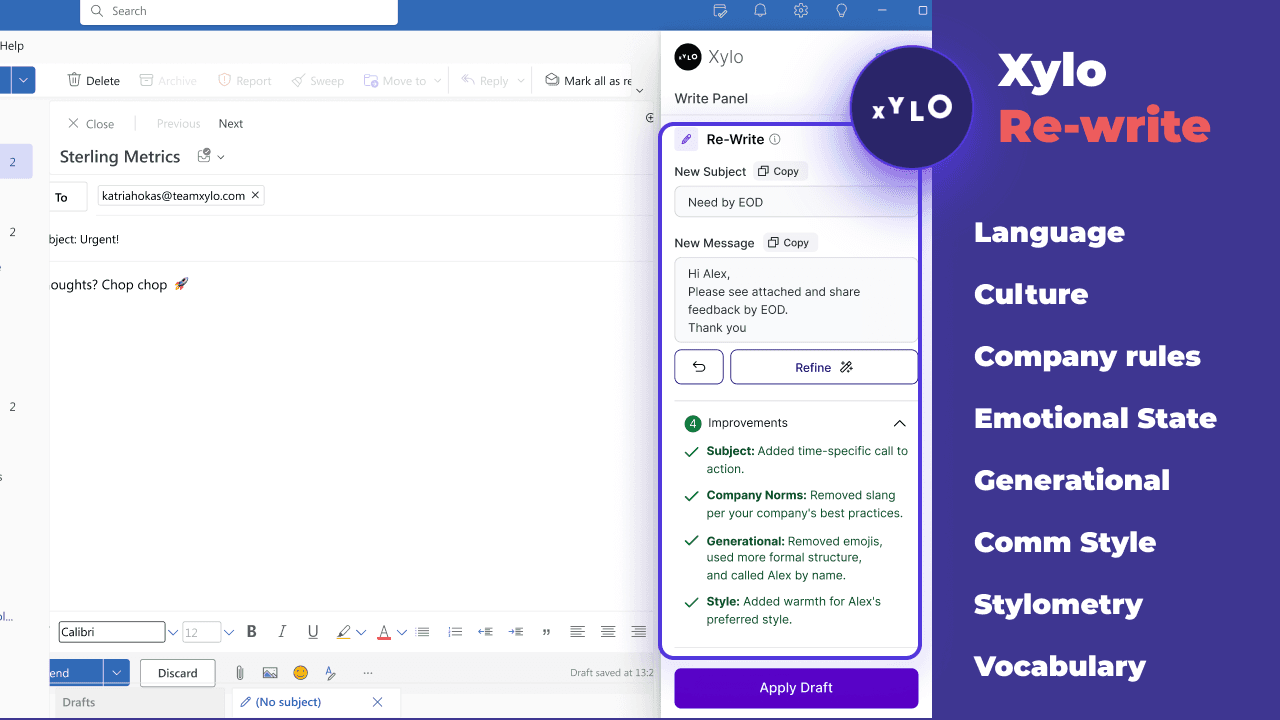How to Write an Email to a College Admissions Office (with Example)
October 8, 2024
How to Write an Email to a College Admissions Office (with Example)
Xylo for Education
In the increasingly competitive world of college admissions, effective communication plays a vital role. Whether you're asking a question about application deadlines, financial aid, or clarifying admission requirements, writing a professional email to the college admissions office can make a big difference in how your query is received and addressed. This article will guide you through the process of writing a well-crafted email that is clear, professional, and likely to get you the information you need.
Additionally, we’ll provide examples and practical tips to ensure your email stands out in a sea of inquiries, helping you make a positive impression on the admissions team.
In this article:
Why Emailing College Admissions Offices Matters
Step-by-Step Guide to Writing a Professional Email
Example of a Well-Written Email to a College Admissions Office
Common Mistakes to Avoid When Emailing a College Admissions Office
Final Thoughts
Why Emailing College Admissions Offices Matters
Many prospective students underestimate the power of a well-written email. A thoughtful, articulate message can do more than just secure an answer; it can reflect your professionalism, initiative, and attention to detail—qualities highly valued by admissions officers. More importantly, clear communication helps to minimize misunderstandings and enables admissions offices to provide accurate, helpful responses.
Email communication also serves as a record of your interaction with the college, which you can refer back to if needed. If you handle this interaction professionally, you establish a favorable connection with the admissions office, which can be beneficial as your application is reviewed.
How to Write an Email to a College Admissions Office: A Step-by-Step Guide
1. Choose a Professional Email Address
Before you even begin writing, ensure your email address is professional. Admissions offices receive hundreds of emails every day, and something as simple as an inappropriate or unprofessional email address could result in your email being overlooked or not taken seriously. If you don’t already have one, create an email address that includes your full name (e.g., john.doe@email.com) to use for college-related communication.
2. Use a Clear and Direct Subject Line
Your subject line should briefly and clearly state the purpose of your email. Be concise but specific so that the admissions officer can immediately understand the topic of your message.
Examples:
Request for Information Regarding Application Deadline
Question About Required Documents for Fall 2025 Admissions
Clarification on Financial Aid Application for Incoming Freshmen
Remember, vague subject lines like "Question" or "Help" are not helpful and may lead to your email being ignored or delayed.
3. Address the Recipient Formally
Begin your email with a formal greeting. It's important to maintain a respectful tone in all your communications with college officials.
Examples of Greetings:
Dear [Name of Admissions Officer],
Dear Admissions Team,
To the Office of Undergraduate Admissions,
If possible, personalize the greeting by addressing a specific person rather than a generic team. You can often find the name of the admissions officer responsible for your area on the college’s website. If you can't find a name, addressing the office as a whole is perfectly acceptable.
4. Introduce Yourself Clearly
In the first paragraph, introduce yourself and explain why you're writing. Be sure to include your full name, your high school, and any other relevant identifying information, such as the term you're applying for or your applicant ID if applicable. This introduction provides context for the admissions office and helps them respond appropriately.
Example Introduction: "My name is Sarah Johnson, and I am a senior at Lincoln High School in Denver, Colorado. I am applying to your college for the Fall 2025 term and have a question regarding the submission of my transcript."
5. State Your Question or Request Succinctly
In the body of your email, get straight to the point. Admissions officers are busy, and they appreciate emails that are clear and concise. State your question or request in a single sentence, if possible, and then provide any additional details that may be necessary.
Example: "Could you please confirm whether the admissions office has received my official SAT scores? I sent them through the College Board system on March 5, 2024."
Make sure to avoid overloading your email with multiple questions. If you have more than one inquiry, consider sending separate emails or combining them in a way that is easy to follow.
6. Express Gratitude and Close Professionally
Always thank the recipient for their time and assistance. Closing with appreciation reinforces the professionalism of your email and leaves a positive impression.
Example Closing: "Thank you for your time and assistance. I look forward to hearing from you soon."
Finish your email with a formal closing, such as:
Sincerely,
Best regards,
Thank you,
Followed by your full name.
7. Proofread Your Email
Before hitting send, proofread your email carefully. Spelling and grammar mistakes can reflect poorly on you and your attention to detail. Taking a few extra minutes to review your email will help ensure it is error-free and professional. Tools like Grammarly or Microsoft Word's built-in spelling and grammar check can help catch errors.
Example of a Well-Written Email to a College Admissions Office
Subject: Clarification on Financial Aid Documents for Fall 2025
Dear [Admissions Officer’s Name],
My name is Michael Reyes, and I am a senior at Westwood High School in Austin, Texas. I am applying for admission to your university for the Fall 2025 term and have a question regarding the financial aid application process.
I have submitted my FAFSA form, but I wanted to confirm if there are any additional financial aid documents that I need to submit directly to your office to be considered for institutional scholarships.
Thank you for your time and assistance. I look forward to your response.
Sincerely,
Michael Reyes
Westwood High School
Austin, TX
Common Mistakes to Avoid When Emailing a College Admissions Office
1. Using Informal Language
Admissions officers expect professional communication. Avoid slang, overly casual language, or emojis in your emails. Keep the tone respectful and businesslike.
2. Not Including Necessary Details
Admissions offices handle thousands of inquiries. Failing to include key information like your name, applicant ID, or specific question can delay a response and lead to confusion.
3. Writing Too Long or Too Vague Emails
Admissions staff appreciate brevity and clarity. Avoid rambling or sending an email with multiple questions that lack focus. A short, concise message is much more effective.
4. Not Following Up Politely
If you don’t receive a response after a reasonable amount of time (typically one to two weeks), it’s appropriate to follow up with a polite reminder. However, avoid being pushy or sending multiple follow-up emails too quickly.
Final Thoughts
Writing an email to a college admissions office may seem daunting, but following these guidelines will help ensure your message is professional, clear, and likely to get a prompt response. With so much at stake in the college admissions process, effective communication can make a significant difference.
By taking the time to craft a thoughtful email, you not only get the answers you need but also demonstrate the professionalism and initiative that colleges are looking for in prospective students.
Whether you're a college student navigating admissions or a college administrator managing countless inquiries, Xylo AI is here to streamline your communication. Save time, reduce errors, and ensure clarity with AI-powered email writing tools tailored for academic needs.
Click here to get it free on your Outlook!
Related articles




